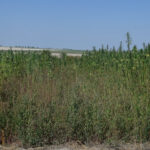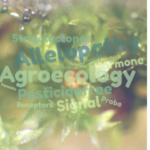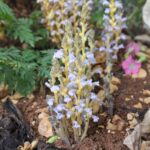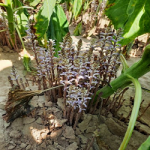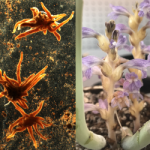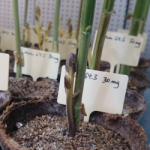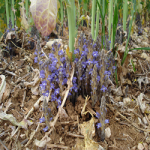Responsable : Philippe DELAVAULT
L’établissement de certaines interactions plante – plante impliquant des plantes parasites obligatoires de racines, telles que les Orobanches, repose sur une signalisation allélochimique encore mal comprise et potentiellement modulable par le microbiome rhizosphérique. Par ailleurs, certaines de ces interactions sont des problématiques agronomiques majeures.
L’équipe Rhizoplante contribue au développement de ressources biochimiques, biologiques, génétiques et génomiques (transcriptomes et génomes) utiles d’une part à la caractérisation des signaux rhizosphériques d’élicitation de la germination et de la formation de l’haustorium des orobanches (Phelipanche ramosa et Orobanche cumana) et d’autre part à l’étude des voies de signalisation induites. Les pathosystèmes Arabidopsis – P. ramosa, colza – P. ramosa et tournesol – O. cumana sont les interactions modèles de l’équipe.
Les recherches actuelles de l’équipe Rhizoplante portent sur :
- la diversité des stimulants de germination (SGs : strigolactones en autres) et des facteurs d’induction de l’haustorium (HIFs : cytokinines entre autres),
- la diversité chez les orobanches des récepteurs KAI2 et HK de ces signaux rhizosphériques (SGs et HIFs, respectivement),
- l’implication du microbiote rhizosphérique dans cette signalisation, particulièrement dans le cadre de l’interaction colza – P. ramosa,
- le développement d’outils génétiques pour des approches de validation fonctionnelle,
- le déterminisme génétique, chimique et moléculaire des résistances à l’orobanche chez les plantes hôtes.
Mots-clés : Allélopathie, interactions plante-plante, microbiome, phytohormones, plantes parasites, rhizosphère, signalisation
Membres
Anciens membres de l'équipe
- Julien AFFHOLDER, Doctorant
- Alioune BA, Technicien de recherche et de formation
- Hocine BENHARRAT, Maître de conférences
- Ahmed CHOUKRI, Stagiaire
- Taycir GRATI, ATER
- Zoé LACOIN, Technicienne de la recherche
- Lisa MARTINEZ, Doctorante
- Lisa MARTINEZ, Ingénieure de recherche
- Sara PENARANDA, Ingénieure de recherche
- Johannes SCHMIDT, Technicien de recherche et de formation
- Nariman ZAINALI, Doctorant
Projets
Anciens projets
Publications
1 publication
Veronesi, Christophe; Billard, Estelle; Delavault, Philippe; Simier, Philippe
(±)-Catechins inhibit prehaustorium formation in the parasitic weed Phelipanche ramosa and reduce tomato infestation Article de journal
Dans: Pest Management Science, vol. 81, no. 2, p. 720-726, 2025.
@article{https://doi.org/10.1002/ps.8472,
title = {(±)-Catechins inhibit prehaustorium formation in the parasitic weed Phelipanche ramosa and reduce tomato infestation},
author = {Christophe Veronesi and Estelle Billard and Philippe Delavault and Philippe Simier},
url = {https://scijournals.onlinelibrary.wiley.com/doi/abs/10.1002/ps.8472},
doi = {https://doi.org/10.1002/ps.8472},
year = {2025},
date = {2025-01-01},
urldate = {2025-01-01},
journal = {Pest Management Science},
volume = {81},
number = {2},
pages = {720-726},
publisher = {Wiley},
abstract = {BACKGROUND Phelipanche ramosa L. (Pomel) is a noxious parasitic weed in field and vegetable crops in Mediterranean countries. Control of this pest is complex and far from being achieved, and new environmentally-friendly strategies are being sought. The present study evaluates the possibility of using (±)-catechins as a natural herbicide against broomrapes.
RESULTS The results show that (±)-catechins have no effect on GR24-induced germination over a wide concentration range (10−4 to 10−10 m), nor on radicle elongation after germination, but strongly inhibit, at 10−4 and 10−5 m, prehaustorium formation in response to the haustorium-inducing factor, cis/trans-zeatin. Accordingly, pot experiments involving the supplies of 10−5 m of (±)-catechins to tomato plants infested or not with P. ramosa demonstrate that (±)-catechins do not influence growth of non-parasitized tomato plants and prevent heavy infestation by strongly reducing parasite attachments and inducing parasite necrosis once they are attached.
CONCLUSION This study points the potential use of (±)-catechins for parasitic weed control. It raises also the question of the mechanisms involved in the inhibition of prehaustorium formation and the necrosis of parasite attachments in response to (±)-catechins application. © 2024 The Author(s). Pest Management Science published by John Wiley & Sons Ltd on behalf of Society of Chemical Industry.},
keywords = {},
pubstate = {published},
tppubtype = {article}
}
RESULTS The results show that (±)-catechins have no effect on GR24-induced germination over a wide concentration range (10−4 to 10−10 m), nor on radicle elongation after germination, but strongly inhibit, at 10−4 and 10−5 m, prehaustorium formation in response to the haustorium-inducing factor, cis/trans-zeatin. Accordingly, pot experiments involving the supplies of 10−5 m of (±)-catechins to tomato plants infested or not with P. ramosa demonstrate that (±)-catechins do not influence growth of non-parasitized tomato plants and prevent heavy infestation by strongly reducing parasite attachments and inducing parasite necrosis once they are attached.
CONCLUSION This study points the potential use of (±)-catechins for parasitic weed control. It raises also the question of the mechanisms involved in the inhibition of prehaustorium formation and the necrosis of parasite attachments in response to (±)-catechins application. © 2024 The Author(s). Pest Management Science published by John Wiley & Sons Ltd on behalf of Society of Chemical Industry.
4 publications
Martinez, Lisa; Pouvreau, Jean-Bernard; Jestin, Christophe; Montiel, Gregory; Gravot, Antoine; Berardocco, Solenne; Marnet, Nathalie; Bouchereau, Alain; Delage, Erwan; Simier, Philippe; Poulin, Lucie
Comparative Analysis of Two Neighboring Conducive and Suppressive Soils Toward Plant Parasitism Caused by Phelipanche ramosa on Brassica napus Article de journal
Dans: Phytobiomes Journal, vol. 8, no. 4, p. 425–445, 2024, ISSN: 2471-2906.
@article{Martinez2024,
title = {Comparative Analysis of Two Neighboring Conducive and Suppressive Soils Toward Plant Parasitism Caused by \textit{Phelipanche ramosa} on \textit{Brassica napus}},
author = {Lisa Martinez and Jean-Bernard Pouvreau and Christophe Jestin and Gregory Montiel and Antoine Gravot and Solenne Berardocco and Nathalie Marnet and Alain Bouchereau and Erwan Delage and Philippe Simier and Lucie Poulin},
doi = {10.1094/pbiomes-12-23-0140-r},
issn = {2471-2906},
year = {2024},
date = {2024-11-00},
urldate = {2024-11-00},
journal = {Phytobiomes Journal},
volume = {8},
number = {4},
pages = {425--445},
publisher = {Scientific Societies},
abstract = {<jats:p> In Western France, rapeseed ( Brassica napus) cultivation faces substantial yield losses due to the root holoparasitic plant Phelipanche ramosa. However, recent observations have shown a reduction in parasitism within previously heavily infested fields. This study investigates two neighboring rapeseed soils with distinct levels of parasitic infestation, considered suppressive and conducive. Using a cocultivation system of Brassica napus and P. ramosa, we comprehensively examined rhizosphere exudates, parasitic plant attachment, and rhizosphere soil microbiota. Our findings revealed that the suppressive soil effectively reduced parasitism by impeding broomrape attachment and development, as well as inducing necrosis of tubercles. This suppressive effect was specific to postattachment stages, leaving germination and haustoriogenesis preattachment stages unaffected. Analysis of microbial structures suggested that the suppression of parasitism is predominantly of fungal rather than bacterial origin. Correlation network analyses identified three groups of amplicon sequence variants (ASVs) associated with suppression. Notably, seven ASVs were inversely correlated with parasitic attachments, and only one ASV, identified as Berkeleyomyces, a necrotrophic fungus responsible for black root rot, was positively correlated with necrosis and was more abundant in the suppressive soil. This study demonstrates the contrasting parasitic plant development on two physicochemically similar soils, highlighting the central role of fungal dynamics in the rhizosphere. These results provide valuable insights into the mechanisms underlying soil-mediated suppression of P. ramosa, offering potential strategies for mitigating the impact of this root holoparasite on rapeseed yields in the region. </jats:p>},
keywords = {},
pubstate = {published},
tppubtype = {article}
}
Veronesi, Christophe; Billard, Estelle; Delavault, Philippe; Simier, Philippe
(±)‐Catechins inhibit prehaustorium formation in the parasitic weed <scp><i>Phelipanche ramosa</i></scp> and reduce tomato infestation Article de journal
Dans: Pest Management Science, 2024, ISSN: 1526-4998.
@article{Veronesi2024b,
title = {(±)‐Catechins inhibit prehaustorium formation in the parasitic weed <scp>\textit{Phelipanche ramosa}</scp> and reduce tomato infestation},
author = {Christophe Veronesi and Estelle Billard and Philippe Delavault and Philippe Simier},
doi = {10.1002/ps.8472},
issn = {1526-4998},
year = {2024},
date = {2024-10-05},
urldate = {2024-10-05},
journal = {Pest Management Science},
publisher = {Wiley},
abstract = {<jats:title>Abstract</jats:title><jats:sec><jats:title>BACKGROUND</jats:title><jats:p><jats:italic>Phelipanche ramosa</jats:italic> L. (Pomel) is a noxious parasitic weed in field and vegetable crops in Mediterranean countries. Control of this pest is complex and far from being achieved, and new environmentally‐friendly strategies are being sought. The present study evaluates the possibility of using (±)‐catechins as a natural herbicide against broomrapes.</jats:p></jats:sec><jats:sec><jats:title>RESULTS</jats:title><jats:p>The results show that (±)‐catechins have no effect on GR24‐induced germination over a wide concentration range (10<jats:sup>−4</jats:sup> to 10<jats:sup>−10</jats:sup> <jats:sc>m</jats:sc>), nor on radicle elongation after germination, but strongly inhibit, at 10<jats:sup>−4</jats:sup> and 10<jats:sup>−5</jats:sup> <jats:sc>m</jats:sc>, prehaustorium formation in response to the haustorium‐inducing factor, <jats:italic>cis/trans</jats:italic>‐zeatin. Accordingly, pot experiments involving the supplies of 10<jats:sup>−5</jats:sup> <jats:sc>m</jats:sc> of (±)‐catechins to tomato plants infested or not with <jats:italic>P</jats:italic>. <jats:italic>ramosa</jats:italic> demonstrate that (±)‐catechins do not influence growth of non‐parasitized tomato plants and prevent heavy infestation by strongly reducing parasite attachments and inducing parasite necrosis once they are attached.</jats:p></jats:sec><jats:sec><jats:title>CONCLUSION</jats:title><jats:p>This study points the potential use of (±)‐catechins for parasitic weed control. It raises also the question of the mechanisms involved in the inhibition of prehaustorium formation and the necrosis of parasite attachments in response to (±)‐catechins application. © 2024 The Author(s). <jats:italic>Pest Management Science</jats:italic> published by John Wiley & Sons Ltd on behalf of Society of Chemical Industry.</jats:p></jats:sec>},
keywords = {},
pubstate = {published},
tppubtype = {article}
}
Grandjean, Cyril; Veronesi, Christophe; Rusterucci, Christine; Gautier, Charlotte; Maillot, Yannis; Leschevin, Maïté; Fournet, Françoise; Drouaud, Jan; Marcelo, Paulo; Zabijak, Luciane; Delavault, Philippe; Simier, Philippe; Bouton, Sophie; Pageau, Karine
Pectin Remodeling and Involvement of AtPME3 in the Parasitic Plant–Plant Interaction, Phelipanche ramosa–Arabidospis thaliana Article de journal
Dans: Plants, vol. 13, no. 15, 2024, ISSN: 2223-7747.
@article{Grandjean2024d,
title = {Pectin Remodeling and Involvement of AtPME3 in the Parasitic Plant–Plant Interaction, Phelipanche ramosa–Arabidospis thaliana},
author = {Cyril Grandjean and Christophe Veronesi and Christine Rusterucci and Charlotte Gautier and Yannis Maillot and Maïté Leschevin and Françoise Fournet and Jan Drouaud and Paulo Marcelo and Luciane Zabijak and Philippe Delavault and Philippe Simier and Sophie Bouton and Karine Pageau},
doi = {10.3390/plants13152168},
issn = {2223-7747},
year = {2024},
date = {2024-08-00},
urldate = {2024-08-00},
journal = {Plants},
volume = {13},
number = {15},
publisher = {MDPI AG},
abstract = {<jats:p>Phelipanche ramosa is a root parasitic plant fully dependent on host plants for nutrition and development. Upon germination, the parasitic seedling develops inside the infected roots a specific organ, the haustorium, thanks to the cell wall-degrading enzymes of haustorial intrusive cells, and induces modifications in the host’s cell walls. The model plant Arabidopsis thaliana is susceptible to P. ramosa; thus, mutants in cell wall metabolism, particularly those involved in pectin remodeling, like Atpme3-1, are of interest in studying the involvement of cell wall-degrading enzymes in the establishment of plant–plant interactions. Host–parasite co-cultures in mini-rhizotron systems revealed that parasite attachments are twice as numerous and tubercle growth is quicker on Atpme3-1 roots than on WT roots. Compared to WT, the increased susceptibility in AtPME3-1 is associated with reduced PME activity in the roots and a lower degree of pectin methylesterification at the host–parasite interface, as detected immunohistochemically in infected roots. In addition, both WT and Atpme3-1 roots responded to infestation by modulating the expression of PAE- and PME-encoding genes, as well as related global enzyme activities in the roots before and after parasite attachment. However, these modulations differed between WT and Atpme3-1, which may contribute to different pectin remodeling in the roots and contrasting susceptibility to P. ramosa. With this integrative study, we aim to define a model of cell wall response to this specific biotic stress and indicate, for the first time, the role of PME3 in this parasitic plant–plant interaction.</jats:p>},
keywords = {},
pubstate = {published},
tppubtype = {article}
}
Jean-Philippe Combier Sabine Tourneur, Serge Plaza
microRNA-encoded peptides inhibit seed germination of the root parasitic plant Orobanche cumana Article de journal
Dans: New Phytologist, 2024.
@article{nokey,
title = {microRNA-encoded peptides inhibit seed germination of the root parasitic plant Orobanche cumana},
author = {Sabine Tourneur, Jean-Philippe Combier, Serge Plaza, Stéphane Muños, Philippe Delavault},
url = {hal-04578646v1 },
doi = { https://doi.org/10.1002/ppp3.10501},
year = {2024},
date = {2024-02-19},
urldate = {2024-02-19},
journal = {New Phytologist},
abstract = {Societal Impact Statement
The root parasitic plant Orobanche cumana (sunflower broomrape) is one of the major pests of sunflower crops. Despite intense efforts to develop effective agricultural practices and breeding programs, selective control of broomrapes is still rare and ineffective in terms of sustainability. It is thus essential to develop new specific control methods against those pests. miRNA-encoded peptides (miPEPs) are a new class of peptides regulating the expression of miRNAs and their corresponding target genes. This study demonstrates that certain miPEPs strongly inhibit the germination of broomrape seeds by regulating their miR gene, making them good candidates for use as biocontrol agents against this pathogen.
Summary
Root parasitic plants of the Orobanchaceae family are a constant and growing threat to agriculture worldwide. Among them, the parasitic weed Orobanche cumana, the sunflower broomrape, causes significant losses to sunflower production in European-Asian and North African countries. Despite the use of several conventional control methods against this pathogen, none has proved effective or durable, underlining the need to develop innovative strategies. miRNA-encoded peptides (miPEPs) are regulatory peptides stimulating the expression of their own primary transcript of miRNA, and plant watering with those molecules leads to down-regulating specifically miRNA target genes and altering plant physiology.
Through seed germination assays and qRT-PCR analysis, we investigated the impact of exogenous treatments of synthetic miPEPs on broomrape seed germination.
First, we report that the conserved miRNA repertoire of O. cumana consists of 39 members. Thirty-nine miPEPs were designed, synthetized, and assayed, 11 of which strongly inhibited O. cumana seed germination. Interestingly, miPEP319a showed the strongest inhibiting effect while miPEP319b did not. Three out of the four corresponding miR319 target genes showed upregulation after treatment with a germination stimulant, which was impaired by treatment with miPEP319a. This downregulation of expression is associated with an increase in the expression of the corresponding pri-miR319a.
We reveal thus that the use of miPEPs can increase our knowledge of key molecular mechanisms underlying a complex parasite interaction and should provide a new phytosanitary method to control broomrape parasitism with highly specific and biodegradable natural substances.
},
keywords = {},
pubstate = {published},
tppubtype = {article}
}
The root parasitic plant Orobanche cumana (sunflower broomrape) is one of the major pests of sunflower crops. Despite intense efforts to develop effective agricultural practices and breeding programs, selective control of broomrapes is still rare and ineffective in terms of sustainability. It is thus essential to develop new specific control methods against those pests. miRNA-encoded peptides (miPEPs) are a new class of peptides regulating the expression of miRNAs and their corresponding target genes. This study demonstrates that certain miPEPs strongly inhibit the germination of broomrape seeds by regulating their miR gene, making them good candidates for use as biocontrol agents against this pathogen.
Summary
Root parasitic plants of the Orobanchaceae family are a constant and growing threat to agriculture worldwide. Among them, the parasitic weed Orobanche cumana, the sunflower broomrape, causes significant losses to sunflower production in European-Asian and North African countries. Despite the use of several conventional control methods against this pathogen, none has proved effective or durable, underlining the need to develop innovative strategies. miRNA-encoded peptides (miPEPs) are regulatory peptides stimulating the expression of their own primary transcript of miRNA, and plant watering with those molecules leads to down-regulating specifically miRNA target genes and altering plant physiology.
Through seed germination assays and qRT-PCR analysis, we investigated the impact of exogenous treatments of synthetic miPEPs on broomrape seed germination.
First, we report that the conserved miRNA repertoire of O. cumana consists of 39 members. Thirty-nine miPEPs were designed, synthetized, and assayed, 11 of which strongly inhibited O. cumana seed germination. Interestingly, miPEP319a showed the strongest inhibiting effect while miPEP319b did not. Three out of the four corresponding miR319 target genes showed upregulation after treatment with a germination stimulant, which was impaired by treatment with miPEP319a. This downregulation of expression is associated with an increase in the expression of the corresponding pri-miR319a.
We reveal thus that the use of miPEPs can increase our knowledge of key molecular mechanisms underlying a complex parasite interaction and should provide a new phytosanitary method to control broomrape parasitism with highly specific and biodegradable natural substances.
3 publications
Philippe Simier Philippe Delavault, Christophe Veronesi
Les plantes parasites Chapitre d'ouvrage
Dans: Phytopathologie, vol. Partie 2, Chapitre 7, p. 130-143, De Boeck Supérieur éditions, Deuxième édition, 2023, ISBN: 9782807302884 .
@inbook{nokey,
title = {Les plantes parasites},
author = {Philippe Delavault, Philippe Simier, Christophe Veronesi},
isbn = { 9782807302884 },
year = {2023},
date = {2023-08-25},
urldate = {2023-08-25},
booktitle = {Phytopathologie},
volume = {Partie 2},
pages = {130-143},
publisher = {De Boeck Supérieur éditions},
edition = {Deuxième édition},
chapter = {7},
keywords = {},
pubstate = {published},
tppubtype = {inbook}
}
Lailheugue, Vincent; Merlin, Isabelle; Boutet, Stéphanie; Perreau, François; Pouvreau, Jean-Bernard; Delgrange, Sabine; Ducrot, Paul-Henri; Cottyn-Boitte, Betty; Mouille, Gregory; Lauvergeat, Virginie
Vitislactone, a non-canonical strigolactone exudated by grapevine rootstocks in response to nitrogen starvation Article de journal
Dans: Phytochemistry, vol. 215, p. 113837, 2023, ISSN: 1873-3700.
@article{pmid37640279,
title = {Vitislactone, a non-canonical strigolactone exudated by grapevine rootstocks in response to nitrogen starvation},
author = {Vincent Lailheugue and Isabelle Merlin and Stéphanie Boutet and François Perreau and Jean-Bernard Pouvreau and Sabine Delgrange and Paul-Henri Ducrot and Betty Cottyn-Boitte and Gregory Mouille and Virginie Lauvergeat},
url = { hal-04247159v1 },
doi = {10.1016/j.phytochem.2023.113837},
issn = {1873-3700},
year = {2023},
date = {2023-08-01},
urldate = {2023-08-01},
journal = {Phytochemistry},
volume = {215},
pages = {113837},
abstract = {Strigolactones are compounds produced by plant roots in response to nutrient deficiency, acting both as local and systemic signals to control development and nutrition. Strigolactones are exuded in the rhizosphere to positively influence interactions with beneficial microbes. LC-MS/MS analysis shows that two genetically distinct grapevine rootstocks exudate one or two non-canonical strigolactones when subjected to low nitrogen conditions. Gene expression profiles and orobanche seed germination assays confirm that the biosynthesis and exudation of non-canonical compounds is the preferred pathway. The first compound, corresponding to heliolactone or 6-epi-heliolactone, is only exuded by the rootstock showing lower shoot branching and a higher level of mycorrhization with arbuscular mycorrhizal fungi. The structure of the second compound exuded by both rootstocks was identified by NMR and LC-MS/MS analysis. It is a non-canonical strigolactone, which has never been identified in another species. This first identification of a natural compound with the potential to stimulate beneficial root-microbe interactions in grapevines opens new perspectives in viticulture.},
keywords = {},
pubstate = {published},
tppubtype = {article}
}
and Claude Becker,; Berthomé, Richard; Delavault, Philippe; Flutre, Timothée; Fréville, Hélène; Gibot-Leclerc, Stéphanie; Corre, Valérie Le; Morel, Jean-Benoit; Moutier, Nathalie; Muños, Stéphane; Richard-Molard, Céline; Westwood, James; Courty, Pierre-Emmanuel; de Saint Germain, Alexandre; Louarn, Gaëtan; Roux, Fabrice
The ecologically relevant genetics of plant-plant interactions Article de journal
Dans: Trends Plant Sci, vol. 28, no. 1, p. 31–42, 2023, ISSN: 1878-4372.
@article{pmid36114125,
title = {The ecologically relevant genetics of plant-plant interactions},
author = { and Claude Becker and Richard Berthomé and Philippe Delavault and Timothée Flutre and Hélène Fréville and Stéphanie Gibot-Leclerc and Valérie Le Corre and Jean-Benoit Morel and Nathalie Moutier and Stéphane Muños and Céline Richard-Molard and James Westwood and Pierre-Emmanuel Courty and Alexandre de Saint Germain and Gaëtan Louarn and Fabrice Roux},
url = {hal-03800896v1 },
doi = {10.1016/j.tplants.2022.08.014},
issn = {1878-4372},
year = {2023},
date = {2023-01-01},
urldate = {2023-01-01},
journal = {Trends Plant Sci},
volume = {28},
number = {1},
pages = {31--42},
abstract = {Interactions among plants have been long recognized as a major force driving plant community dynamics and crop yield. Surprisingly, our knowledge of the ecological genetics associated with variation of plant-plant interactions remains limited. In this opinion article by scientists from complementary disciplines, the international PLANTCOM network identified four timely questions to foster a better understanding of the mechanisms mediating plant assemblages. We propose that by identifying the key relationships among phenotypic traits involved in plant-plant interactions and the underlying adaptive genetic and molecular pathways, while considering environmental fluctuations at diverse spatial and time scales, we can improve predictions of genotype-by-genotype-by-environment interactions and modeling of productive and stable plant assemblages in wild habitats and crop fields.},
keywords = {},
pubstate = {published},
tppubtype = {article}
}
3 publications
Martinez, Lisa; Pouvreau, Jean-Bernard; Montiel, Gregory; Jestin, Christophe; Delavault, Philippe; Simier, Philippe; Poulin, Lucie
Soil microbiota promotes early developmental stages of Phelipanche ramosa L. Pomel during plant parasitism on Brassica napus L. Article de journal
Dans: Plant and Soil, vol. 483, p. 667–691 , 2022.
@article{martinez2022soil,
title = {Soil microbiota promotes early developmental stages of Phelipanche ramosa L. Pomel during plant parasitism on Brassica napus L.},
author = {Lisa Martinez and Jean-Bernard Pouvreau and Gregory Montiel and Christophe Jestin and Philippe Delavault and Philippe Simier and Lucie Poulin},
url = {https://nantes-universite.hal.science/hal-04370677v1 },
doi = {https://doi.org/10.1007/s11104-022-05822-6},
year = {2022},
date = {2022-12-08},
urldate = {2022-12-08},
journal = {Plant and Soil},
volume = {483},
pages = {667–691 },
publisher = {Springer},
abstract = {Purpose
The root holoparasitic plant Phelipanche ramosa has become a major constraint for rapeseed cultivation in western France for the last decades and its control remains challenging. To date, few studies have considered soil microbiota as a third partner of the parasitic plant-plant interaction. Therefore, we here addressed the question of how soil microbiota interferes with host-derived signal metabolites required for host plant recognition by the parasitic plant.
Methods
Using a branched broomrape infested soil (genetic group 1) from a rapeseed field, we first provided soil physicochemical and microbiological descriptions by metabarcoding, followed by P. ramosa seed germination and prehaustorium formation bioassays, and by in vitro co-cultivation with Brassica napus.
Results
Co-cultivation in presence of soil microorganisms promoted parasitic plant seed germination and attachments to host’s roots. Seed germination assays showed that only the combination of gluconasturtiin (main rapeseed glucosinolate) with soil extracts stimulated broomrape germination. This suggests a microbial conversion of gluconasturtiin into germination stimulants via soil microbial myrosinase enzymes. Furthermore, soil bacteria Arthrobacter, Ralstonia, Actinobacterium, Proteobacterium spp. and fungus Penicillium spp. were isolated and screened for myrosinase activity. Pre-germinated seeds treated with soil extracts or differentially filtrated soil extracts also promoted the formation of P. ramosa prehaustorium and led to more parasitic attachments on rapeseed roots in co-cultivation assays. This thus suggests that this enhancement of parasitic attachments could also be partly attributed to soil microbial production of haustorium inducing factors.
Conclusion
Soil microbiota influences B. napus - P. ramosa interaction by altering direct and indirect recognition signals.},
keywords = {},
pubstate = {published},
tppubtype = {article}
}
The root holoparasitic plant Phelipanche ramosa has become a major constraint for rapeseed cultivation in western France for the last decades and its control remains challenging. To date, few studies have considered soil microbiota as a third partner of the parasitic plant-plant interaction. Therefore, we here addressed the question of how soil microbiota interferes with host-derived signal metabolites required for host plant recognition by the parasitic plant.
Methods
Using a branched broomrape infested soil (genetic group 1) from a rapeseed field, we first provided soil physicochemical and microbiological descriptions by metabarcoding, followed by P. ramosa seed germination and prehaustorium formation bioassays, and by in vitro co-cultivation with Brassica napus.
Results
Co-cultivation in presence of soil microorganisms promoted parasitic plant seed germination and attachments to host’s roots. Seed germination assays showed that only the combination of gluconasturtiin (main rapeseed glucosinolate) with soil extracts stimulated broomrape germination. This suggests a microbial conversion of gluconasturtiin into germination stimulants via soil microbial myrosinase enzymes. Furthermore, soil bacteria Arthrobacter, Ralstonia, Actinobacterium, Proteobacterium spp. and fungus Penicillium spp. were isolated and screened for myrosinase activity. Pre-germinated seeds treated with soil extracts or differentially filtrated soil extracts also promoted the formation of P. ramosa prehaustorium and led to more parasitic attachments on rapeseed roots in co-cultivation assays. This thus suggests that this enhancement of parasitic attachments could also be partly attributed to soil microbial production of haustorium inducing factors.
Conclusion
Soil microbiota influences B. napus - P. ramosa interaction by altering direct and indirect recognition signals.
Fornier, Suzanne Daignan; de Saint Germain, Alexandre; Retailleau, Pascal; Pillot, Jean-Paul; Taulera, Quentin; Andna, Lucile; Miesch, Laurence; Rochange, Soizic; Pouvreau, Jean-Bernard; Boyer, François-Didier
Noncanonical Strigolactone Analogues Highlight Selectivity for Stimulating Germination in Two Populations Article de journal
Dans: J Nat Prod, vol. 85, no. 8, p. 1976–1992, 2022, ISSN: 1520-6025.
@article{pmid35776904,
title = {Noncanonical Strigolactone Analogues Highlight Selectivity for Stimulating Germination in Two Populations},
author = {Suzanne Daignan Fornier and Alexandre de Saint Germain and Pascal Retailleau and Jean-Paul Pillot and Quentin Taulera and Lucile Andna and Laurence Miesch and Soizic Rochange and Jean-Bernard Pouvreau and François-Didier Boyer},
url = {hal-03712428v1 },
doi = {10.1021/acs.jnatprod.2c00282},
issn = {1520-6025},
year = {2022},
date = {2022-08-01},
urldate = {2022-08-01},
journal = {J Nat Prod},
volume = {85},
number = {8},
pages = {1976--1992},
abstract = {Strigolactones (SLs) are plant hormones exuded in the rhizosphere with a signaling role for the development of arbuscular mycorrhizal (AM) fungi and as stimulants of seed germination of the parasitic weeds , , and , the most threatening weeds of major crops worldwide. is present mainly on rape, hemp, and tobacco in France. 2a preferentially attacks hemp, while 1 attacks rapeseed. The recently isolated cannalactone () from hemp root exudates has been characterized as a noncanonical SL that selectively stimulates the germination of 2a seeds in comparison with 1. In the present work, (-)-solanacol (), a canonical orobanchol-type SL exuded by tobacco and tomato, was established to possess a remarkable selective germination stimulant activity for 2a seeds. Two cannalactone analogues, named (±)-SdL19 and (±)-SdL118, have been synthesized. They have an unsaturated acyclic carbon chain with a tertiary hydroxy group and a methyl or a cyclopropyl group instead of a cyclohexane A-ring, respectively. (±)-SdL analogues are able to selectively stimulate 2a, revealing that these minimal structural elements are key for this selective bioactivity. In addition, (±)-SdL19 is able to inhibit shoot branching in and and induces hyphal branching in the AM fungus , like SLs.},
keywords = {},
pubstate = {published},
tppubtype = {article}
}
Chabaud, Mireille; Auriac, Marie-Christine; Boniface, Marie-Claude; Delgrange, Sabine; Folletti, Tifaine; Jardinaud, Marie-Françoise; Legendre, Alexandra; Pérez-Vich, Begoña; Pouvreau, Jean-Bernard; Velasco, Leonardo; Delavault, Philippe; Muños, Stéphane
Wild species: A reservoir of resistance genes for sustainable pyramidal resistance to broomrape in sunflower Article de journal
Dans: Front Plant Sci, vol. 13, p. 1038684, 2022, ISSN: 1664-462X.
@article{pmid36340383,
title = {Wild species: A reservoir of resistance genes for sustainable pyramidal resistance to broomrape in sunflower},
author = {Mireille Chabaud and Marie-Christine Auriac and Marie-Claude Boniface and Sabine Delgrange and Tifaine Folletti and Marie-Françoise Jardinaud and Alexandra Legendre and Begoña Pérez-Vich and Jean-Bernard Pouvreau and Leonardo Velasco and Philippe Delavault and Stéphane Muños},
url = {hal-03877893v1 },
doi = {10.3389/fpls.2022.1038684},
issn = {1664-462X},
year = {2022},
date = {2022-01-01},
urldate = {2022-01-01},
journal = {Front Plant Sci},
volume = {13},
pages = {1038684},
abstract = { Wall., sunflower broomrape, is one of the major pests for the sunflower crop. Breeding for resistant varieties in sunflower has been the most efficient method to control this parasitic weed. However, more virulent broomrape populations continuously emerge by overcoming genetic resistance. It is thus essential to identify new broomrape resistances acting at various stages of the interaction and combine them to improve resistance durability. In this study, 71 wild sunflowers and wild relatives accessions from 16 species were screened in pots for their resistance to broomrape at the late emergence stage. From this initial screen, 18 accessions from 9 species showing resistance, were phenotyped at early stages of the interaction: the induction of broomrape seed germination by sunflower root exudates, the attachment to the host root and the development of tubercles in rhizotron assays. We showed that wild accessions are an important source of resistance to the most virulent broomrape races, affecting various stages of the interaction: the inability to induce broomrape seed germination, the development of incompatible attachments or necrotic tubercles, and the arrest of emerged structure growth. Cytological studies of incompatible attachments showed that several cellular mechanisms were shared among resistant species.},
keywords = {},
pubstate = {published},
tppubtype = {article}
}
5 publications
Cornet, Florent; Pillot, Jean-Paul; Bris, Philippe Le; Pouvreau, Jean-Bernard; Arnaud, Nicolas; de Saint Germain, Alexandre; Rameau, Catherine
Strigolactones (SLs) modulate the plastochron by regulating KLUH (KLU) transcript abundance in Arabidopsis Article de journal
Dans: New Phytol, vol. 232, no. 5, p. 1909–1916, 2021, ISSN: 1469-8137.
@article{pmid34498760,
title = {Strigolactones (SLs) modulate the plastochron by regulating KLUH (KLU) transcript abundance in Arabidopsis},
author = {Florent Cornet and Jean-Paul Pillot and Philippe Le Bris and Jean-Bernard Pouvreau and Nicolas Arnaud and Alexandre de Saint Germain and Catherine Rameau},
doi = {10.1111/nph.17725},
issn = {1469-8137},
year = {2021},
date = {2021-12-01},
urldate = {2021-12-01},
journal = {New Phytol},
volume = {232},
number = {5},
pages = {1909--1916},
abstract = {The timing of leaf emergence at the shoot apical meristem, or plastochron, is highly regulated in plants. Among the genes known to regulate the plastochron in Arabidopsis (Arabidopsis thaliana), KLUH (KLU), orthologous to the rice (Oryza sativa) PLASTOCHRON1, encodes the cytochrome P450 CYP78A5, and is thought to act through generation of a still unknown mobile signal. As klu mutants display not only a short plastochron but also a branching phenotype reminiscent of strigolactone (SL) mutants, we investigated whether KLU/CYP78A5 is involved in SL biosynthesis. We combined a genetic approach, a parasitic plant seed germination bioassay to test klu root exudates, and analysis of transcript abundances of SL-biosynthesis genes in the Arabidopsis klu mutants. We demonstrate that KLU is not involved in the SL-biosynthesis pathway. Moreover, this work allowed us to uncover a new role for SL during Arabidopsis development in modulating plastochron via a KLU-dependent pathway. Globally our data reveal that KLU is required for plastochron-specific SL responses, a first indication of crosstalk between SL and the KLU-derived signal.},
keywords = {},
pubstate = {published},
tppubtype = {article}
}
Germain, Alexandre Saint; Jacobs, Anse; Brun, Guillaume; Pouvreau, Jean-Bernard; Braem, Lukas; Cornu, David; Clavé, Guillaume; Baudu, Emmanuelle; Steinmetz, Vincent; Servajean, Vincent; Wicke, Susann; Gevaert, Kris; Simier, Philippe; Goormachtig, Sophie; Delavault, Philippe; Boyer, François-Didier
A Phelipanche ramosa KAI2 protein perceives strigolactones and isothiocyanates enzymatically Article de journal
Dans: Plant Commun, vol. 2, no. 5, p. 100166, 2021, ISSN: 2590-3462.
@article{RN13,
title = {A Phelipanche ramosa KAI2 protein perceives strigolactones and isothiocyanates enzymatically},
author = {Alexandre Saint Germain and Anse Jacobs and Guillaume Brun and Jean-Bernard Pouvreau and Lukas Braem and David Cornu and Guillaume Clavé and Emmanuelle Baudu and Vincent Steinmetz and Vincent Servajean and Susann Wicke and Kris Gevaert and Philippe Simier and Sophie Goormachtig and Philippe Delavault and François-Didier Boyer},
url = {https://www.ncbi.nlm.nih.gov/pmc/articles/PMC8553955/pdf/main.pdf},
doi = {10.1016/j.xplc.2021.100166},
issn = {2590-3462},
year = {2021},
date = {2021-01-01},
urldate = {2021-01-01},
journal = {Plant Commun},
volume = {2},
number = {5},
pages = {100166},
abstract = {Phelipanche ramosa is an obligate root-parasitic weed that threatens major crops in central Europe. In order to germinate, it must perceive various structurally divergent host-exuded signals, including isothiocyanates (ITCs) and strigolactones (SLs). However, the receptors involved are still uncharacterized. Here, we identify five putative SL receptors in P. ramosa and show that PrKAI2d3 is involved in the stimulation of seed germination. We demonstrate the high plasticity of PrKAI2d3, which allows it to interact with different chemicals, including ITCs. The SL perception mechanism of PrKAI2d3 is similar to that of endogenous SLs in non-parasitic plants. We provide evidence that PrKAI2d3 enzymatic activity confers hypersensitivity to SLs. Additionally, we demonstrate that methylbutenolide-OH binds PrKAI2d3 and stimulates P. ramosa germination with bioactivity comparable to that of ITCs. This study demonstrates that P. ramosa has extended its signal perception system during evolution, a fact that should be considered for the development of specific and efficient biocontrol methods.},
keywords = {},
pubstate = {published},
tppubtype = {article}
}
Pouvreau, Jean-Bernard; Poulin, Lucie; Huet, Sarah; Delavault, Philippe
Strigolactone-Like Bioactivity via Parasitic Plant Germination Bioassay Article de journal
Dans: Methods Mol Biol, vol. 2309, p. 59–73, 2021, ISSN: 1940-6029.
@article{pmid34028679b,
title = {Strigolactone-Like Bioactivity via Parasitic Plant Germination Bioassay},
author = {Jean-Bernard Pouvreau and Lucie Poulin and Sarah Huet and Philippe Delavault},
doi = {10.1007/978-1-0716-1429-7_6},
issn = {1940-6029},
year = {2021},
date = {2021-01-01},
urldate = {2021-01-01},
journal = {Methods Mol Biol},
volume = {2309},
pages = {59--73},
abstract = {Strigolactones are a class of plant hormones involved in shoot branching, growth of symbiotic arbuscular mycorrhizal fungi, and germination of parasitic plant seeds. Assaying new molecules or compound exhibiting strigolactone-like activities is therefore important but unfortunately time-consuming and hard to implement because of the extremely low concentrations at which they are active. Seeds of parasite plants are natural integrator of these hormones since they can perceive molecule concentrations in the picomolar to nanomolar range stimulating their germination. Here we describe a simple and inexpensive method to evaluate the activity of these molecules by scoring the germination of parasitic plant seeds upon treatment with these molecules. Up to four molecules can be assayed from a single 96-well plate by this method. A comparison of SL-like bioactivities between molecules is done by determining the EC50 and the maximum percentage of germination.},
keywords = {},
pubstate = {published},
tppubtype = {article}
}
Brun, Guillaume; Spallek, Thomas; Simier, Philippe; Delavault, Philippe
Molecular actors of seed germination and haustoriogenesis in parasitic weeds Article de journal
Dans: Plant Physiol, vol. 185, no. 4, p. 1270-1281, 2021, ISSN: 0032-0889 (Print) 0032-0889.
@article{RN8,
title = {Molecular actors of seed germination and haustoriogenesis in parasitic weeds},
author = {Guillaume Brun and Thomas Spallek and Philippe Simier and Philippe Delavault},
url = {https://www.ncbi.nlm.nih.gov/pmc/articles/PMC8133557/pdf/kiaa041.pdf},
doi = {10.1093/plphys/kiaa041},
issn = {0032-0889 (Print) 0032-0889},
year = {2021},
date = {2021-01-01},
urldate = {2021-01-01},
journal = {Plant Physiol},
volume = {185},
number = {4},
pages = {1270-1281},
abstract = {One-sentence summary Recent advances provide insight into the molecular mechanisms underlying host-dependent seed germination and haustorium formation in parasitic plants.},
keywords = {},
pubstate = {published},
tppubtype = {article}
}
Lopez-Obando, Mauricio; Guillory, Ambre; Boyer, François-Didier; Cornu, David; Hoffmann, Beate; Bris, Philippe Le; Pouvreau, Jean-Bernard; Delavault, Philippe; Rameau, Catherine; Germain, Alexandre Saint; Bonhomme, Sandrine
The Physcomitrium (Physcomitrella) patens PpKAI2L receptors for strigolactones and related compounds function via MAX2-dependent and -independent pathways Article de journal
Dans: Plant Cell, vol. 33, no. 11, p. 3487-3512, 2021, ISSN: 1040-4651 (Print) 1040-4651.
@article{RN27,
title = {The Physcomitrium (Physcomitrella) patens PpKAI2L receptors for strigolactones and related compounds function via MAX2-dependent and -independent pathways},
author = {Mauricio Lopez-Obando and Ambre Guillory and François-Didier Boyer and David Cornu and Beate Hoffmann and Philippe Le Bris and Jean-Bernard Pouvreau and Philippe Delavault and Catherine Rameau and Alexandre Saint Germain and Sandrine Bonhomme},
url = {https://academic.oup.com/plcell/article-abstract/33/11/3487/6359828?redirectedFrom=fulltext},
doi = {10.1093/plcell/koab217},
issn = {1040-4651 (Print) 1040-4651},
year = {2021},
date = {2021-01-01},
urldate = {2021-01-01},
journal = {Plant Cell},
volume = {33},
number = {11},
pages = {3487-3512},
abstract = {In angiosperms, the α/β hydrolase DWARF14 (D14), along with the F-box protein MORE AXILLARY GROWTH2 (MAX2), perceives strigolactones (SL) to regulate developmental processes. The key SL biosynthetic enzyme CAROTENOID CLEAVAGE DIOXYGENASE8 (CCD8) is present in the moss Physcomitrium patens, and PpCCD8-derived compounds regulate moss extension. The PpMAX2 homolog is not involved in the SL response, but 13 PpKAI2LIKE (PpKAI2L) genes homologous to the D14 ancestral paralog KARRIKIN INSENSITIVE2 (KAI2) encode candidate SL receptors. In Arabidopsis thaliana, AtKAI2 perceives karrikins and the elusive endogenous KAI2-Ligand (KL). Here, germination assays of the parasitic plant Phelipanche ramosa suggested that PpCCD8-derived compounds are likely noncanonical SLs. (+)-GR24 SL analog is a good mimic for PpCCD8-derived compounds in P. patens, while the effects of its enantiomer (-)-GR24, a KL mimic in angiosperms, are minimal. Interaction and binding assays of seven PpKAI2L proteins pointed to the stereoselectivity toward (-)-GR24 for a single clade of PpKAI2L (eu-KAI2). Enzyme assays highlighted the peculiar behavior of PpKAI2L-H. Phenotypic characterization of Ppkai2l mutants showed that eu-KAI2 genes are not involved in the perception of PpCCD8-derived compounds but act in a PpMAX2-dependent pathway. In contrast, mutations in PpKAI2L-G, and -J genes abolished the response to the (+)-GR24 enantiomer, suggesting that PpKAI2L-G, and -J proteins are receptors for moss SLs.},
keywords = {},
pubstate = {published},
tppubtype = {article}
}
4 publications
Huet, Sarah; Pouvreau, Jean-Bernard; Delage, Erwan; Delgrange, Sabine; Marais, Coralie; Bahut, Muriel; Delavault, Philippe; Simier, Philippe; Poulin, Lucie
Populations of the Parasitic Plant Influence Their Seed Microbiota Article de journal
Dans: Front Plant Sci, vol. 11, p. 1075, 2020, ISSN: 1664-462X.
@article{pmid32765559,
title = {Populations of the Parasitic Plant Influence Their Seed Microbiota},
author = {Sarah Huet and Jean-Bernard Pouvreau and Erwan Delage and Sabine Delgrange and Coralie Marais and Muriel Bahut and Philippe Delavault and Philippe Simier and Lucie Poulin},
doi = {10.3389/fpls.2020.01075},
issn = {1664-462X},
year = {2020},
date = {2020-01-01},
urldate = {2020-01-01},
journal = {Front Plant Sci},
volume = {11},
pages = {1075},
abstract = {Seeds of the parasitic weed are well adapted to their hosts because they germinate and form haustorial structures to connect to roots in response to diverse host-derived molecular signals. presents different genetic groups that are preferentially adapted to certain hosts. Since there are indications that microbes play a role in the interaction especially in the early stages of the interaction, we studied the microbial diversity harbored by the parasitic seeds with respect to their host and genetic group. Twenty-six seed lots from seven cropping plots of three different hosts-oilseed rape, tobacco, and hemp-in the west of France were characterized for their bacterial and fungal communities using 16S rRNA gene and ITS (Internal transcribed spacer) sequences, respectively. First seeds were characterized genetically using twenty microsatellite markers and phenotyped for their sensibility to various germination stimulants including strigolactones and isothiocyanates. This led to the distinction of three groups that corresponded to their host of origin. The observed seed diversity was correlated to the host specialization and germination stimulant sensitivity within species. Microbial communities were both clustered by host and plot of origin. The seed core microbiota was composed of seventeen species that were also retrieved from soil and was in lower abundances for bacteria and similar abundances for fungi compared to seeds. The host-related core microbiota of parasitic seeds was limited and presumably well adapted to the interaction with its hosts. Two microbial candidates of species and were especially identified in seeds from oilseed rape plots, suggesting their involvement in host recognition and specialization as well as seed fitness for by improving the production of isothiocyanates from glucosinolates in the rhizosphere of oilseed rape.},
keywords = {},
pubstate = {published},
tppubtype = {article}
}
Delavault, Philippe
Are root parasitic plants like any other plant pathogens? Article de journal
Dans: New Phytol, vol. 226, no. 3, p. 641-643, 2020, ISSN: 0028-646x.
@article{RN2,
title = {Are root parasitic plants like any other plant pathogens?},
author = {Philippe Delavault},
url = {https://nph.onlinelibrary.wiley.com/doi/10.1111/nph.16504},
doi = {10.1111/nph.16504},
issn = {0028-646x},
year = {2020},
date = {2020-01-01},
urldate = {2020-01-01},
journal = {New Phytol},
volume = {226},
number = {3},
pages = {641-643},
keywords = {},
pubstate = {published},
tppubtype = {article}
}
Billard, Estelle; Goyet, Vincent; Delavault, Philippe; Simier, Philippe; Montiel, Grégory
Correction to: Cytokinin treated microcalli of Phelipanche ramosa: an efficient model for studying haustorium formation in holoparasitic plants Article de journal
Dans: Plant Cell, Tissue and Organ Culture (PCTOC), vol. 141, no. 3, p. 555-555, 2020, ISSN: 1573-5044.
@article{RN31,
title = {Correction to: Cytokinin treated microcalli of Phelipanche ramosa: an efficient model for studying haustorium formation in holoparasitic plants},
author = {Estelle Billard and Vincent Goyet and Philippe Delavault and Philippe Simier and Grégory Montiel},
url = {https://doi.org/10.1007/s11240-020-01832-3
https://link.springer.com/content/pdf/10.1007/s11240-020-01832-3.pdf},
doi = {10.1007/s11240-020-01832-3},
issn = {1573-5044},
year = {2020},
date = {2020-01-01},
urldate = {2020-01-01},
journal = {Plant Cell, Tissue and Organ Culture (PCTOC)},
volume = {141},
number = {3},
pages = {555-555},
abstract = {The caption to Fig. 4 belonged to Fig. 5 and vice versa in the initial online publication. The original article has been corrected.},
keywords = {},
pubstate = {published},
tppubtype = {article}
}
Fernández-Aparicio, Monica; Delavault, Philippe; Timko, Michael
Management of Infection by Parasitic Weeds: A Review Article de journal
Dans: Plants (Basel), vol. 9, no. 9, 2020, ISSN: 2223-7747 (Print) 2223-7747.
@article{RN3,
title = {Management of Infection by Parasitic Weeds: A Review},
author = {Monica Fernández-Aparicio and Philippe Delavault and Michael Timko},
url = {https://mdpi-res.com/d_attachment/plants/plants-09-01184/article_deploy/plants-09-01184.pdf},
doi = {10.3390/plants9091184},
issn = {2223-7747 (Print) 2223-7747},
year = {2020},
date = {2020-01-01},
urldate = {2020-01-01},
journal = {Plants (Basel)},
volume = {9},
number = {9},
abstract = {Parasitic plants rely on neighboring host plants to complete their life cycle, forming vascular connections through which they withdraw needed nutritive resources. In natural ecosystems, parasitic plants form one component of the plant community and parasitism contributes to overall community balance. In contrast, when parasitic plants become established in low biodiversified agroecosystems, their persistence causes tremendous yield losses rendering agricultural lands uncultivable. The control of parasitic weeds is challenging because there are few sources of crop resistance and it is difficult to apply controlling methods selective enough to kill the weeds without damaging the crop to which they are physically and biochemically attached. The management of parasitic weeds is also hindered by their high fecundity, dispersal efficiency, persistent seedbank, and rapid responses to changes in agricultural practices, which allow them to adapt to new hosts and manifest increased aggressiveness against new resistant cultivars. New understanding of the physiological and molecular mechanisms behind the processes of germination and haustorium development, and behind the crop resistant response, in addition to the discovery of new targets for herbicides and bioherbicides will guide researchers on the design of modern agricultural strategies for more effective, durable, and health compatible parasitic weed control.},
keywords = {},
pubstate = {published},
tppubtype = {article}
}
3 publications
de Saint Germain, Alexandre; Retailleau, Pascal; Norsikian, Stéphanie; Servajean, Vincent; Pelissier, Franck; Steinmetz, Vincent; Pillot, Jean-Paul; Rochange, Soizic; Pouvreau, Jean-Bernard; Boyer, François-Didier
Contalactone, a contaminant formed during chemical synthesis of the strigolactone reference GR24 is also a strigolactone mimic Article de journal
Dans: Phytochemistry, vol. 168, p. 112112, 2019, ISSN: 1873-3700.
@article{pmid31499274,
title = {Contalactone, a contaminant formed during chemical synthesis of the strigolactone reference GR24 is also a strigolactone mimic},
author = {Alexandre de Saint Germain and Pascal Retailleau and Stéphanie Norsikian and Vincent Servajean and Franck Pelissier and Vincent Steinmetz and Jean-Paul Pillot and Soizic Rochange and Jean-Bernard Pouvreau and François-Didier Boyer},
url = {hal-03010596v1 },
doi = {10.1016/j.phytochem.2019.112112},
issn = {1873-3700},
year = {2019},
date = {2019-12-01},
urldate = {2019-12-01},
journal = {Phytochemistry},
volume = {168},
pages = {112112},
abstract = {Strigolactone (SL) plant hormones control plant architecture and are key players in both symbiotic and parasitic interactions. GR24, a synthetic SL analog, is the worldwide reference compound used in all bioassays for investigating the role of SLs in plant development and in rhizospheric interactions. In 2012, the first characterization of the SL receptor reported the detection of an unknown compound after incubation of GR24 samples with the SL receptor. We reveal here the origin of this compound (P270), which comes from a by-product formed during GR24 chemical synthesis. We present the identification of this by-product, named contalactone. A proposed chemical pathway for its formation is provided as well as an evaluation of its bioactivity on pea, Arabidopsis, root parasitic plant seeds and AM fungi, characterizing it as a SL mimic. Quality of GR24 samples can be easily checked by carrying out microscale hydrolysis in a basic aqueous medium to easily detect P270 as indicator of the presence of the contalactone impurity. In all cases, before being used for bioassays, GR24 must be careful purified by preparative HPLC.},
keywords = {},
pubstate = {published},
tppubtype = {article}
}
Brun, Guillaume; Thoiron, Séverine; Braem, Lukas; Pouvreau, Jean-Bernard; Montiel, Grégory; Lechat, Marc-Marie; Simier, Philippe; Gevaert, Kris; Goormachtig, Sophie; Delavault, Philippe
CYP707As are effectors of karrikin and strigolactone signalling pathways in Arabidopsis thaliana and parasitic plants Article de journal
Dans: Plant Cell Environ, vol. 42, no. 9, p. 2612-2626, 2019, ISSN: 0140-7791.
@article{RN7,
title = {CYP707As are effectors of karrikin and strigolactone signalling pathways in Arabidopsis thaliana and parasitic plants},
author = {Guillaume Brun and Séverine Thoiron and Lukas Braem and Jean-Bernard Pouvreau and Grégory Montiel and Marc-Marie Lechat and Philippe Simier and Kris Gevaert and Sophie Goormachtig and Philippe Delavault},
url = {https://onlinelibrary.wiley.com/doi/10.1111/pce.13594},
doi = {10.1111/pce.13594},
issn = {0140-7791},
year = {2019},
date = {2019-01-01},
urldate = {2019-01-01},
journal = {Plant Cell Environ},
volume = {42},
number = {9},
pages = {2612-2626},
abstract = {Karrikins stimulate Arabidopsis thaliana germination, whereas parasitic weeds of the Orobanchaceae family have evolved to respond to host-exuded compounds such as strigolactones, dehydrocostus lactone, and 2-phenylethyl isothiocyanate. In Phelipanche ramosa, strigolactone-induced germination was shown to require one of the CYP707A proteins involved in abscisic acid catabolism. Here, germination and gene expression were analysed to investigate the role of CYP707As in germination of both parasitic plants and Arabidopsis upon perception of germination stimulants, after using pharmacological inhibitors and Arabidopsis mutants disrupting germination signals. CYP707A genes were up-regulated upon treatment with effective germination stimulants in both parasitic plants and Arabidopsis. Obligate parasitic plants exhibited both intensified up-regulation of CYP707A genes and increased sensitivity to the CYP707A inhibitor abscinazole-E2B, whereas Arabidopsis cyp707a mutants still positively responded to germination stimulation. In Arabidopsis, CYP707A regulation required the canonical karrikin signalling pathway KAI2/MAX2/SMAX1 and the transcription factor WRKY33. Finally, CYP707As and WRKY33 also modulated Arabidopsis root architecture in response to the synthetic strigolactone rac-GR24, and wrky33-1 exhibited a shoot hyperbranched phenotype. This study suggests that the lack of host-independent germination in obligate parasites is associated with an exacerbated CYP707A induction and that CYP707As and WRKY33 are new players involved in a variety of strigolactone/karrikin responses.},
keywords = {},
pubstate = {published},
tppubtype = {article}
}
Stojanova, Bojana; Delourme, Régine; Duffé, Philippe; Delavault, Philippe; Simier, Philippe
Genetic differentiation and host preference reveal non-exclusive host races in the generalist parasitic weed Phelipanche ramosa Article de journal
Dans: Weed Research, vol. 59, no. 2, p. 107-118, 2019, ISSN: 0043-1737.
@article{RN32,
title = {Genetic differentiation and host preference reveal non-exclusive host races in the generalist parasitic weed Phelipanche ramosa},
author = {Bojana Stojanova and Régine Delourme and Philippe Duffé and Philippe Delavault and Philippe Simier},
url = {https://onlinelibrary.wiley.com/doi/abs/10.1111/wre.12353
https://onlinelibrary.wiley.com/doi/10.1111/wre.12353},
doi = {https://doi.org/10.1111/wre.12353},
issn = {0043-1737},
year = {2019},
date = {2019-01-01},
urldate = {2019-01-01},
journal = {Weed Research},
volume = {59},
number = {2},
pages = {107-118},
abstract = {Summary We developed 20 microsatellite markers to genotype over 100 populations of the parasitic weed Phelipanche ramosa, which covers a wide host crop and geographic range. A representative core collection of 15 populations was also used in cross-infestation assays to study host preference during germination, attachment and shoot formation. We observed low genetic differentiation within most of the populations, but high genetic differentiation between populations partitioned into 3 genetic groups with different host preferences and geographic distributions. Genetic group 1 is detected exclusively in western France and on various host crops, notably winter oilseed rape (WOSR) and not hemp. Cross-infection assays confirmed its incompatibility with hemp and showed its preference for WOSR and tobacco in terms of germination and attachment success. The group 2 populations share a large geographic distribution in France and Europe, low germination success with WOSR and high germination success, attachment success and shoot formation with hemp, tobacco or tomato. The subclades 2a and 2b include most of the French populations in hemp crops in eastern France and in tobacco fields in several European countries respectively. The genetic analyses revealed the potential of the three groups to increase their geographic range in the future. Intermediate genetic groups showed higher intrapopulation diversity and represent potential stocks for new host race emergence. Those findings argue in favour of the existence of host races in P. ramosa and should be considered for appropriate management strategies, notably in breeding programmes for resistance against this parasitic weed.},
keywords = {},
pubstate = {published},
tppubtype = {article}
}
2 publications
Cochetel, Noé; Météier, Eloïse; Merlin, Isabelle; Hévin, Cyril; Pouvreau, Jean-Bernard; Coutos-Thévenot, Pierre; Hernould, Michel; Vivin, Philippe; Cookson, Sarah Jane; Ollat, Nathalie; Lauvergeat, Virginie
Potential contribution of strigolactones in regulating scion growth and branching in grafted grapevine in response to nitrogen availability Article de journal
Dans: J Exp Bot, vol. 69, no. 16, p. 4099–4112, 2018, ISSN: 1460-2431.
@article{pmid29860350,
title = {Potential contribution of strigolactones in regulating scion growth and branching in grafted grapevine in response to nitrogen availability},
author = {Noé Cochetel and Eloïse Météier and Isabelle Merlin and Cyril Hévin and Jean-Bernard Pouvreau and Pierre Coutos-Thévenot and Michel Hernould and Philippe Vivin and Sarah Jane Cookson and Nathalie Ollat and Virginie Lauvergeat},
doi = {10.1093/jxb/ery206},
issn = {1460-2431},
year = {2018},
date = {2018-07-01},
urldate = {2018-07-01},
journal = {J Exp Bot},
volume = {69},
number = {16},
pages = {4099--4112},
abstract = {In grafted plants, rootstocks assure the mineral nutrition of the scion and modify its development. In this study, we show that two grapevine rootstock genotypes have different shoot branching architectures when cultivated as cuttings and that this trait is transmitted to the scion when grafted. Shoot branching plasticity in response to nitrogen supply was also studied. As strigolactones are known to have a role in the regulation of shoot development in response to nutrient availability, their involvement in the control of scion architecture by the rootstock was investigated. Functional characterization of putative grapevine strigolactone biosynthetic genes in Arabidopsis mutants or grapevine cell suspensions showed similar functions to those of Arabidopsis. Both rootstocks produced strigolactone-like compounds; the quantity produced in response to nitrogen treatments differed between the two rootstock genotypes and correlated with the expression of putative strigolactone biosynthetic genes. Exudation of strigolactone-like compounds by both rootstocks was closely related to the developmental pattern of the scion in grafted plants. These results suggest that differential regulation of strigolactone biosynthesis in response to nitrogen availability may contribute to the control of scion development conferred by each rootstock genotype.},
keywords = {},
pubstate = {published},
tppubtype = {article}
}
Brun, Guillaume; Braem, Lukas; Thoiron, Séverine; Gevaert, Kris; Goormachtig, Sophie; Delavault, Philippe
Seed germination in parasitic plants: what insights can we expect from strigolactone research? Article de journal
Dans: J Exp Bot, vol. 69, no. 9, p. 2265-2280, 2018, ISSN: 0022-0957.
@article{RN5,
title = {Seed germination in parasitic plants: what insights can we expect from strigolactone research?},
author = {Guillaume Brun and Lukas Braem and Séverine Thoiron and Kris Gevaert and Sophie Goormachtig and Philippe Delavault},
url = {https://watermark.silverchair.com/erx472.pdf?token=AQECAHi208BE49Ooan9kkhW_Ercy7Dm3ZL_9Cf3qfKAc485ysgAAAt4wggLaBgkqhkiG9w0BBwagggLLMIICxwIBADCCAsAGCSqGSIb3DQEHATAeBglghkgBZQMEAS4wEQQM1yniRk8_noMBOyNMAgEQgIICkQSx0NkVWTLILIUWSlmnkftHgPP-m5t-cQPJknvKituLwilM0lvjYzZ8hS9XgfOcZXtWI5s8xbpatlB8cdpZP9UIDbsBGHsUHt7S7HlpuAZMTQ45haVuNqJvyuKge5jMk7hS88X3g81iv7EI3sBpzHd2YIKMfNhaf48kbTwwrzS4DRYGNAvL4WBc-raLQpiuWzkwcigfD-aABZkBD1-gFe8IEUnOb2RkmjlUr_liOJU7PFy_Cx4vIQEP2JYFSTWPLCUjkUom_5WQQc6OEtCE9DM41tXRLSckgbL81--d43m9Fej8gsZ4BfyxtqW2HQeS-iOmIDEWFFSwij_htBntsNJyL2q_vklyiqNPmXnr7aAG5USvV7SKNyBXBLiZMhcK4LNAPAEXOmSdSzYuMfXoO0kbljSM6ht_Z5lxwGuDDEByCqSieqyirwwsSP5G7zjEwBgLyWku3qPSVQlSht3Zw5syxIR8XT1sWmvYDcKEttmpmlsNbJCFK8vfRSi8KeAAbs1zSzg17FzgpZCOkqRY5GKdESZfeVuNdyzEA5rlbuLLEKwV2LRm2RAg8b2ygsderPTNrSDDfwLwbN5VRWZF7lyhSHemRqDOnYU59ezeS882026E4kS2LpG_zwSjma0HyCHEE2GNywtVrwKfa_0_gKE1Q-OQ8INzeshP-lrHHZqa8Q4bZLCQXLfyE1qlJnLTroDX4UIpRRhA1Ildrf_lGv2vFlPxs9DzFqjLPoqsmb5cBVdv819hiJTgqzR4v-Nm2sw1H5Vp2V8l6aPIab9ijg3ZIlpm-B6VUnUsjZA5gxKdSDHHZzIQluh9wxsUc6c_WYBWNA20_EOSP9ALg-sQsplZk3VAb1WhQh7antobYSAx_A},
doi = {10.1093/jxb/erx472},
issn = {0022-0957},
year = {2018},
date = {2018-01-01},
urldate = {2018-01-01},
journal = {J Exp Bot},
volume = {69},
number = {9},
pages = {2265-2280},
abstract = {Obligate root-parasitic plants belonging to the Orobanchaceae family are deadly pests for major crops all over the world. Because these heterotrophic plants severely damage their hosts even before emerging from the soil, there is an unequivocal need to design early and efficient methods for their control. The germination process of these species has probably undergone numerous selective pressure events in the course of evolution, in that the perception of host-derived molecules is a necessary condition for seeds to germinate. Although most of these molecules belong to the strigolactones, structurally different molecules have been identified. Since strigolactones are also classified as novel plant hormones that regulate several physiological processes other than germination, the use of autotrophic model plant species has allowed the identification of many actors involved in the strigolactone biosynthesis, perception, and signal transduction pathways. Nevertheless, many questions remain to be answered regarding the germination process of parasitic plants. For instance, how did parasitic plants evolve to germinate in response to a wide variety of molecules, while autotrophic plants do not? What particular features are associated with their lack of spontaneous germination? In this review, we attempt to illustrate to what extent conclusions from research into strigolactones could be applied to better understand the biology of parasitic plants.},
keywords = {},
pubstate = {published},
tppubtype = {article}
}
1 publication
Goyet, Vincent; Billard, Estelle; Pouvreau, Jean-Bernard; Lechat, Marc-Marie; Pelletier, Sandra; Bahut, Muriel; Monteau, Fabrice; Spíchal, Lukas; Delavault, Philippe; Montiel, Grégory; Simier, Philippe
Haustorium initiation in the obligate parasitic plant Phelipanche ramosa involves a host-exudated cytokinin signal Article de journal
Dans: J Exp Bot, vol. 68, no. 20, p. 5539-5552, 2017, ISSN: 0022-0957 (Print) 0022-0957.
@article{RN11,
title = {Haustorium initiation in the obligate parasitic plant Phelipanche ramosa involves a host-exudated cytokinin signal},
author = {Vincent Goyet and Estelle Billard and Jean-Bernard Pouvreau and Marc-Marie Lechat and Sandra Pelletier and Muriel Bahut and Fabrice Monteau and Lukas Spíchal and Philippe Delavault and Grégory Montiel and Philippe Simier},
url = {https://www.ncbi.nlm.nih.gov/pmc/articles/PMC5853424/pdf/erx359.pdf},
doi = {10.1093/jxb/erx359},
issn = {0022-0957 (Print) 0022-0957},
year = {2017},
date = {2017-01-01},
urldate = {2017-01-01},
journal = {J Exp Bot},
volume = {68},
number = {20},
pages = {5539-5552},
abstract = {The heterotrophic lifestyle of parasitic plants relies on the development of the haustorium, a specific infectious organ required for attachment to host roots. While haustorium development is initiated upon chemodetection of host-derived molecules in hemiparasitic plants, the induction of haustorium formation remains largely unknown in holoparasitic species such as Phelipanche ramosa. This work demonstrates that the root exudates of the host plant Brassica napus contain allelochemicals displaying haustorium-inducing activity on P. ramosa germinating seeds, which increases the parasite aggressiveness. A de novo assembled transcriptome and microarray approach with P. ramosa during early haustorium formation upon treatment with B. napus root exudates allowed the identification of differentially expressed genes involved in hormone signaling. Bioassays using exogenous cytokinins and the specific cytokinin receptor inhibitor PI-55 showed that cytokinins induced haustorium formation and increased parasite aggressiveness. Root exudates triggered the expression of cytokinin-responsive genes during early haustorium development in germinated seeds, and bio-guided UPLC-ESI(+)-/MS/MS analysis showed that these exudates contain a cytokinin with dihydrozeatin characteristics. These results suggest that cytokinins constitutively exudated from host roots play a major role in haustorium formation and aggressiveness in P. ramosa.},
keywords = {},
pubstate = {published},
tppubtype = {article}
}
3 publications
Rolland, Mathieu; Dupuy, Aurélie; Pelleray, Aude; Delavault, Philippe
Molecular Identification of Broomrape Species from a Single Seed by High Resolution Melting Analysis Article de journal
Dans: Front Plant Sci, vol. 7, p. 1838, 2016, ISSN: 1664-462X (Print) 1664-462x.
@article{RN12,
title = {Molecular Identification of Broomrape Species from a Single Seed by High Resolution Melting Analysis},
author = {Mathieu Rolland and Aurélie Dupuy and Aude Pelleray and Philippe Delavault},
url = {https://www.ncbi.nlm.nih.gov/pmc/articles/PMC5149549/pdf/fpls-07-01838.pdf},
doi = {10.3389/fpls.2016.01838},
issn = {1664-462X (Print) 1664-462x},
year = {2016},
date = {2016-01-01},
urldate = {2016-01-01},
journal = {Front Plant Sci},
volume = {7},
pages = {1838},
abstract = {Broomrapes are holoparasitic plants spreading through seeds. Each plant produces hundreds of thousands of seeds which remain viable in the soils for decades. To limit their spread, drastic measures are being taken and the contamination of a commercial seed lot by a single broomrape seed can lead to its rejection. Considering that broomrapes species identification from a single seed is extremely difficult even for trained botanists and that among all the described species, only a few are really noxious for the crops, numerous seed lots are rejected because of the contamination by seeds of non-noxious broomrape species. The aim of this study was to develop and evaluate a High Resolution Melting assay identifying the eight most noxious and common broomrape species (Phelipanche aegyptiaca, Orobanche cernua, O. crenata, O. cumana, O. foetida, O. hederae, O. minor, and P. ramosa) from a single seed. Based on trnL and rbcL plastidial genes amplification, the designed assay successfully identifies O. cumana, O. cernua, O. crenata, O. minor, O. hederae, and O. foetida; P. ramosa, and P. aegyptiaca can be differentiated from other species but not from each other. Tested on 50 seed lots, obtained results perfectly matched identifications performed by sequencing. Through the analysis of common seed lots by different analysts, the reproducibility of the assay was evaluated at 90%. Despite an original sample preparation process it was not possible to extract enough DNA from some seeds (10% of the samples). The described assay fulfills its objectives and allows an accurate identification of the targeted broomrape species. It can be used to identify contaminants in commercial seed lots or for any other purpose. The assay might be extended to vegetative material.},
keywords = {},
pubstate = {published},
tppubtype = {article}
}
Péron, Thomas; Candat, Adrien; Montiel, Grégory; Veronesi, Christophe; Macherel, David; Delavault, Philippe; Simier, Philippe
New Insights into Phloem Unloading and Expression of Sucrose Transporters in Vegetative Sinks of the Parasitic Plant Phelipanche ramosa L. (Pomel) Article de journal
Dans: Front Plant Sci, vol. 7, p. 2048, 2016, ISSN: 1664-462X (Print) 1664-462x.
@article{RN23,
title = {New Insights into Phloem Unloading and Expression of Sucrose Transporters in Vegetative Sinks of the Parasitic Plant Phelipanche ramosa L. (Pomel)},
author = {Thomas Péron and Adrien Candat and Grégory Montiel and Christophe Veronesi and David Macherel and Philippe Delavault and Philippe Simier},
url = {https://www.ncbi.nlm.nih.gov/pmc/articles/PMC5220101/pdf/fpls-07-02048.pdf},
doi = {10.3389/fpls.2016.02048},
issn = {1664-462X (Print) 1664-462x},
year = {2016},
date = {2016-01-01},
urldate = {2016-01-01},
journal = {Front Plant Sci},
volume = {7},
pages = {2048},
abstract = {The plant-parasitic plant interaction is a interesting model to study sink-source relationship and phloem unloading. The parasitic plants, such as the achlorophyllous plant Phelipanche ramosa, connect to the host phloem through the haustorium and act as supernumerary sinks for the host-derived photoassimilates, primarily sucrose. The application of the fluorescent symplastic tracer, carboxyfluorescein (CF) derived from carboxyfluorescein diacetate (CFDA), to the leaves of the host plant (Brassica napus) showed direct phloem connections at the host-parasite interface. These experiments also evidenced the dominant apoplastic pathway for phloem unloading in major vegetative sinks of the parasite, including tubercles and shoots, except the adventitious root apices. The CF experiments showed also the symplastic isolation of the phloem tissues from the sink tissues in tubercle and shoot of the parasite, then suggesting the pivotal role of sucrose transporters in sucrose unloading in P. ramosa sinks. Three cDNAs encoding sucrose transporters (PrSUT) were isolated from the parasitic plant. PrSUT1 transcripts accumulated at the same level in the tubercle throughout the parasite growth while a significant increase in transcript accumulation occurred after emergence in the flowering shoot, notably in the growing apical part. The in situ hybridization experiments revealed the PrSUT1 transcript accumulation in the mature phloem cells of both subterranean and flowering shoots, as well as in shoot terminal sinks corresponding to apical meristem, scale leaf primordia and immature vasculature. The transient expression experiments in Arabidopsis protoplasts showed that PrSUT1 was localized at the plasma membrane, suggesting its role in phloem functioning and sucrose uptake by the sink cells in P. ramosa. Conversely, the PrSUT2 transcript accumulation was constantly low in tubercles and shoots but PrSUT3 transcripts accumulated markedly in the subterranean and flowering shoots, in concordance with the PrSUT3 mRNA accumulation in multiple sink areas including apical meristem, scale-leaf primordia, immature vasculature and even storage parenchyma. However, the PrSUT3 transcripts did not accumulate in the mature phloem cells. The transient expression experiments in Arabidopsis protoplasts suggested a tonoplast localization of PrSUT3, for which nevertheless the involvement in intracellular sucrose transport needs clarification.},
keywords = {},
pubstate = {published},
tppubtype = {article}
}
Brahmi, Ines; Mabrouk, Yassine; Brun, Guillaume; Delavault, Philippe; Belhadj, Omrane; Simier, Philippe
Phenotypical and biochemical characterisation of resistance for parasitic weed (Orobanche foetida Poir.) in radiation-mutagenised mutants of chickpea Article de journal
Dans: Pest Manag Sci, vol. 72, no. 12, p. 2330-2338, 2016, ISSN: 1526-498x.
@article{RN16,
title = {Phenotypical and biochemical characterisation of resistance for parasitic weed (Orobanche foetida Poir.) in radiation-mutagenised mutants of chickpea},
author = {Ines Brahmi and Yassine Mabrouk and Guillaume Brun and Philippe Delavault and Omrane Belhadj and Philippe Simier},
url = {https://onlinelibrary.wiley.com/doi/10.1002/ps.4278},
doi = {10.1002/ps.4278},
issn = {1526-498x},
year = {2016},
date = {2016-01-01},
urldate = {2016-01-01},
journal = {Pest Manag Sci},
volume = {72},
number = {12},
pages = {2330-2338},
abstract = {BACKGROUND: Some radiation-mutagenised chickpea mutants potentially resistant to the broomrape, Orobanche foetida Poir., were selected through field trials. The objectives of this work were to confirm resistance under artificial infestation, in pots and mini-rhizotron systems, and to determine the developmental stages of broomrape affected by resistance and the relevant resistance mechanisms induced by radiation mutagenesis. RESULTS: Among 30 mutants tested for resistance to O. foetida, five shared strong resistance in both pot experiments and mini-rhizotron systems. Resistance was not complete, but the few individuals that escaped resistance displayed high disorders of shoot development. Results demonstrated a 2-3-fold decrease in stimulatory activity of root exudates towards broomrape seed germination in resistant mutants in comparison with non-irradiated control plants and susceptible mutants. Resistance was associated with an induction of broomrape necrosis early during infection. When infested, most of the resistant mutants shared enhanced levels of soluble phenolic contents, phenylalanine ammonia lyase activity, guaiacol peroxidase activity and polyphenol oxidase activity, in addition to glutathione and notably ascorbate peroxidase gene expression in roots. CONCLUSION: Results confirmed enhanced resistance in chickpea radiation-mutagenised mutants, and demonstrated that resistance is based on alteration of root exudation, presumed cell-wall reinforcement and change in root oxidative status in response to infection. © 2016 Society of Chemical Industry.},
keywords = {},
pubstate = {published},
tppubtype = {article}
}
3 publications
Molinero-Ruiz, Leire; Delavault, Philippe; Pérez-Vich, Begoña; Pacureanu-Joita, Maria; Bulos, Mariano; Altieri, Emiliano; Domínguez, Juan
History of the race structure of Orobanche cumana and the breeding of sunflower for resistance to this parasitic weed: A review Article de journal
Dans: Spanish Journal of Agricultural Research, vol. 13, no. 4, p. e10R01, 2015.
@article{RN34,
title = {History of the race structure of Orobanche cumana and the breeding of sunflower for resistance to this parasitic weed: A review},
author = {Leire Molinero-Ruiz and Philippe Delavault and Begoña Pérez-Vich and Maria Pacureanu-Joita and Mariano Bulos and Emiliano Altieri and Juan Domínguez},
url = {https://revistas.inia.es/index.php/sjar/article/view/8080
https://revistas.inia.es/index.php/sjar/article/download/8080/2588},
doi = {10.5424/sjar/2015134-8080},
year = {2015},
date = {2015-01-01},
urldate = {2015-01-01},
journal = {Spanish Journal of Agricultural Research},
volume = {13},
number = {4},
pages = {e10R01},
abstract = {Broomrape, caused by Orobanche cumana, has affected sunflowers since the early 20th century in Eastern Europe. Currently, it limits sunflower oil production in Southern and Eastern Europe and in some areas of Asia, causing around 50% seed losses when susceptible hybrids are grown. Covered in this review are aspects such as: biological processes that are common to Orobanche spp. and/or particular to O. cumana in sunflower, genetic resistance and its mechanisms, races of the parasite identified in different countries throughout the time and their increasing virulence, and breeding for resistance to some herbicides as a novel control option. The main purpose is to present an updated and, as far as possible, complete picture of the way both the parasitic weed and its host crop have evolved in time, and how they co-exist in the current agriculture. Additionally, we propose a system for determining the races of the parasite that can be internationally adopted from now. In the context of minimal harmful effects on the environment, changing patterns of land use in farming systems, and global environment changes, the final goal of this work is to provide all those interested in parasites from field crops and their integrated management compiled information on the sunflower – O. cumana system as a case study.},
keywords = {},
pubstate = {published},
tppubtype = {article}
}
Delavault, Philippe
Knowing the Parasite: Biology and Genetics of Orobanche Article de journal
Dans: Helia, vol. 38, no. 62, p. 15-29, 2015.
@article{RN33,
title = {Knowing the Parasite: Biology and Genetics of Orobanche},
author = {Philippe Delavault},
url = {https://doi.org/10.1515/helia-2014-0030},
doi = {doi:10.1515/helia-2014-0030},
year = {2015},
date = {2015-01-01},
urldate = {2015-01-01},
journal = {Helia},
volume = {38},
number = {62},
pages = {15-29},
keywords = {},
pubstate = {published},
tppubtype = {article}
}
Lechat, Marc-Marie; Brun, Guillaume; Montiel, Grégory; Véronési, Christophe; Simier, Philippe; Thoiron, Séverine; Pouvreau, Jean-Bernard; Delavault, Philippe
Seed response to strigolactone is controlled by abscisic acid-independent DNA methylation in the obligate root parasitic plant, Phelipanche ramosa L. Pomel Article de journal
Dans: J Exp Bot, vol. 66, no. 11, p. 3129-40, 2015, ISSN: 0022-0957 (Print) 0022-0957.
@article{RN22,
title = {Seed response to strigolactone is controlled by abscisic acid-independent DNA methylation in the obligate root parasitic plant, Phelipanche ramosa L. Pomel},
author = {Marc-Marie Lechat and Guillaume Brun and Grégory Montiel and Christophe Véronési and Philippe Simier and Séverine Thoiron and Jean-Bernard Pouvreau and Philippe Delavault},
url = {https://www.ncbi.nlm.nih.gov/pmc/articles/PMC4449535/pdf/erv119.pdf},
doi = {10.1093/jxb/erv119},
issn = {0022-0957 (Print) 0022-0957},
year = {2015},
date = {2015-01-01},
urldate = {2015-01-01},
journal = {J Exp Bot},
volume = {66},
number = {11},
pages = {3129-40},
abstract = {Seed dormancy release of the obligate root parasitic plant, Phelipanche ramosa, requires a minimum 4-day conditioning period followed by stimulation by host-derived germination stimulants, such as strigolactones. Germination is then mediated by germination stimulant-dependent activation of PrCYP707A1, an abscisic acid catabolic gene. The molecular mechanisms occurring during the conditioning period that silence PrCYP707A1 expression and regulate germination stimulant response are almost unknown. Here, global DNA methylation quantification associated with pharmacological approaches and cytosine methylation analysis of the PrCYP707A1 promoter were used to investigate the modulation and possible role of DNA methylation during the conditioning period and in the PrCYP707A1 response to GR24, a synthetic strigolactone analogue. Active global DNA demethylation occurs during the conditioning period and is required for PrCYP707A1 activation by GR24 and for subsequent seed germination. Treatment with 5-azacytidine, a DNA-hypomethylating molecule, reduces the length of the conditioning period. Conversely, hydroxyurea, a hypermethylating agent, inhibits PrCYP707A1 expression and seed germination. Methylated DNA immunoprecipitation followed by PCR experiments and bisulfite sequencing revealed that DNA demethylation particularly impacts a 78-nucleotide sequence in the PrCYP707A1 promoter. The results here demonstrate that the DNA methylation status during the conditioning period plays a crucial role independently of abscisic acid in the regulation of P. ramosa seed germination by controlling the strigolactone-dependent expression of PrCYP707A1.},
keywords = {},
pubstate = {published},
tppubtype = {article}
}











